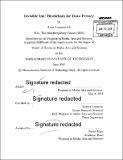| dc.contributor.advisor | Andrew Lippman. | en_US |
| dc.contributor.author | Lazarovich, Amir | en_US |
| dc.contributor.other | Massachusetts Institute of Technology. Department of Architecture. Program in Media Arts and Sciences. | en_US |
| dc.date.accessioned | 2015-09-17T19:00:35Z | |
| dc.date.available | 2015-09-17T19:00:35Z | |
| dc.date.copyright | 2015 | en_US |
| dc.date.issued | 2015 | en_US |
| dc.identifier.uri | http://hdl.handle.net/1721.1/98626 | |
| dc.description | Thesis: S.M., Massachusetts Institute of Technology, School of Architecture and Planning, Program in Media Arts and Sciences, 2015. | en_US |
| dc.description | Cataloged from PDF version of thesis. | en_US |
| dc.description | Includes bibliographical references (pages 81-85). | en_US |
| dc.description.abstract | The problem of maintaining complete control over and transparency with regard to our digital identity is growing more urgent as our lives become more dependent on online and digital services. What once was rightfully ours and under our control is now spread among uncountable entities across many locations. We have built a platform that securely distributes encrypted user-sensitive data. It uses the Bitcoin blockchain to keep a trust-less audit trail for data interactions and to manage access to user data. Our platform offers advantages to both users and service providers. The user enjoys the heightened transparency, control, and security of their personal data, while the service provider becomes much less vulnerable to single point-of failures and breaches, which in turn decreases their exposure to information-security liability, thereby saving them money and protecting their brand. Our work extends an idea developed by the author and two collaborators, a peer-to- peer network that uses blockchain technology and off-blockchain storage to securely distribute sensitive data in a decentralized manner using a custom blockchain protocol. Our two main contributions are: 1. developing this platform and 2. analyzing its feasibility in real-world applications. This includes designing a protocol for data authentication that runs on an Internet scale peer-to-peer network, abstracting complex interactions with encrypted data, building a dashboard for data auditing and management, as well as building servers and sample services that use this platform for testing and evaluation. This work has been supported by the MIT Communication Futures Program and the Digital Life Consortium. | en_US |
| dc.description.statementofresponsibility | by Amir Lazarovich. | en_US |
| dc.format.extent | 85 pages | en_US |
| dc.language.iso | eng | en_US |
| dc.publisher | Massachusetts Institute of Technology | en_US |
| dc.rights | M.I.T. theses are protected by copyright. They may be viewed from this source for any purpose, but reproduction or distribution in any format is prohibited without written permission. See provided URL for inquiries about permission. | en_US |
| dc.rights.uri | http://dspace.mit.edu/handle/1721.1/7582 | en_US |
| dc.subject | Architecture. Program in Media Arts and Sciences. | en_US |
| dc.title | Invisible Ink : blockchain for data privacy | en_US |
| dc.title.alternative | Blockchain for data privacy | en_US |
| dc.type | Thesis | en_US |
| dc.description.degree | S.M. | en_US |
| dc.contributor.department | Program in Media Arts and Sciences (Massachusetts Institute of Technology) | |
| dc.identifier.oclc | 920475053 | en_US |
